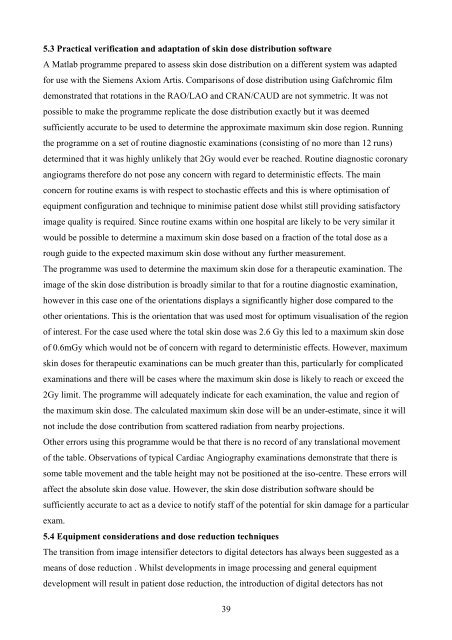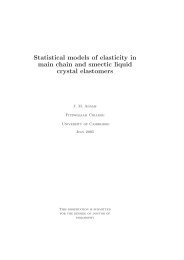Sandra Hopkins Final Report.pdf - University of Surrey
Sandra Hopkins Final Report.pdf - University of Surrey
Sandra Hopkins Final Report.pdf - University of Surrey
Create successful ePaper yourself
Turn your PDF publications into a flip-book with our unique Google optimized e-Paper software.
5.3 Practical verification and adaptation <strong>of</strong> skin dose distribution s<strong>of</strong>twareA Matlab programme prepared to assess skin dose distribution on a different system was adaptedfor use with the Siemens Axiom Artis. Comparisons <strong>of</strong> dose distribution using Gafchromic filmdemonstrated that rotations in the RAO/LAO and CRAN/CAUD are not symmetric. It was notpossible to make the programme replicate the dose distribution exactly but it was deemedsufficiently accurate to be used to determine the approximate maximum skin dose region. Runningthe programme on a set <strong>of</strong> routine diagnostic examinations (consisting <strong>of</strong> no more than 12 runs)determined that it was highly unlikely that 2Gy would ever be reached. Routine diagnostic coronaryangiograms therefore do not pose any concern with regard to deterministic effects. The mainconcern for routine exams is with respect to stochastic effects and this is where optimisation <strong>of</strong>equipment configuration and technique to minimise patient dose whilst still providing satisfactoryimage quality is required. Since routine exams within one hospital are likely to be very similar itwould be possible to determine a maximum skin dose based on a fraction <strong>of</strong> the total dose as arough guide to the expected maximum skin dose without any further measurement.The programme was used to determine the maximum skin dose for a therapeutic examination. Theimage <strong>of</strong> the skin dose distribution is broadly similar to that for a routine diagnostic examination,however in this case one <strong>of</strong> the orientations displays a significantly higher dose compared to theother orientations. This is the orientation that was used most for optimum visualisation <strong>of</strong> the region<strong>of</strong> interest. For the case used where the total skin dose was 2.6 Gy this led to a maximum skin dose<strong>of</strong> 0.6mGy which would not be <strong>of</strong> concern with regard to deterministic effects. However, maximumskin doses for therapeutic examinations can be much greater than this, particularly for complicatedexaminations and there will be cases where the maximum skin dose is likely to reach or exceed the2Gy limit. The programme will adequately indicate for each examination, the value and region <strong>of</strong>the maximum skin dose. The calculated maximum skin dose will be an under-estimate, since it willnot include the dose contribution from scattered radiation from nearby projections.Other errors using this programme would be that there is no record <strong>of</strong> any translational movement<strong>of</strong> the table. Observations <strong>of</strong> typical Cardiac Angiography examinations demonstrate that there issome table movement and the table height may not be positioned at the iso-centre. These errors willaffect the absolute skin dose value. However, the skin dose distribution s<strong>of</strong>tware should besufficiently accurate to act as a device to notify staff <strong>of</strong> the potential for skin damage for a particularexam.5.4 Equipment considerations and dose reduction techniquesThe transition from image intensifier detectors to digital detectors has always been suggested as ameans <strong>of</strong> dose reduction . Whilst developments in image processing and general equipmentdevelopment will result in patient dose reduction, the introduction <strong>of</strong> digital detectors has not39
















